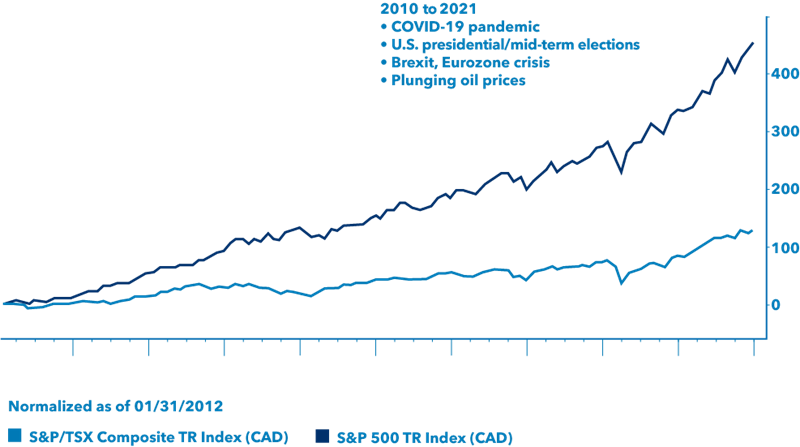Investing early and staying invested are two seemingly simple strategies that many of us struggle to capitalize on, for varying reasons. Let’s explore why.
The chart below shows how investing in financial markets early compares with saving your money in cash. The benefits of investing are easy to see. The Anderson family didn’t make any gains because they held onto their cash, choosing not to invest. The Bourque and Chan families made identical investments with the same annual contributions, earning a 7% annualized return. However, the Chans had a longer time horizon (the window of time you have as an investor), by starting their investment 15 years earlier. Despite only contributing $150,000 more during that period, by taking advantage of more compound growth, their savings grew by an additional $1.3 million.
| Anderson |
Bourque | Chan | ||||
|---|---|---|---|---|---|---|
| Holding savings in cash earning no return over 25 years | Investing over 25 years | Investing over 40 years | ||||
| Beginning investment | $5,000 | $5,000 | $5,000 | |||
| Rate of return (annualized) | 0 | 7.00% | 7.00% | |||
| Investment period (years) | 25 | 25 | 40 | |||
| Payment per period | $10,000 | $10,000 | $10,000 | |||
| Future value | $255,000 | $703,902 | $2,210,968 | |||
| Total amount invested | $255,000 | $255,000 | $405,000 | |||
| Future value | $255,000 | $703,902 | $2,210,968 | |||
| Total gain | $0 | $448,902 | $1,805,968 |
Assuming all families are classified as "Aggressive" investors. Past performance is not indicative of future returns. A client's situation and returns may vary. Tax implications have not been considered.
Compounding returns and tax considerations
The biggest challenge that prevents investors from getting an early start, thereby extending their time horizon, is finding money to set aside early in life – when their income may be lower and they have large expenses like student dept or a mortgage. One way to reverse the impact of a later start is by reinvesting the returns you earn along with your ongoing contributions. This is known as compounding. Investments like mutual funds and segregated funds also pay income each year, called distributions, that can be reinvested. And, if you have these investments within a registered account like a registered retirement savings plan (RRSP) or tax-free savings account (TFSA), you can reduce or eliminate the tax you pay on what you earn.
It only works if you stay invested
The graph below highlights major global events that have impacted financial markets over the last decade, and how markets responded in the years that followed. In the more recent two-year span from 2020 to 2022 alone, investors experienced a historical market collapse, then an unprecedented recovery, followed by a period of unpredictable volatility, as inflation, war and global supply chains issues led to erratic returns. There is no guarantee of future performance, but the data below highlights that Canada’s S&P/TSX Composite and the S&P 500 have continued to trend upward.

1Source: Bloomberg Finance LP. From January 31, 2012, to January 31, 2022. Past performance does not guarantee future results.
By definition, each market cycle includes a “downtrend” phase. If that period is prolonged by unexpected or atypical world events like a war, or economic factors like inflation, it can seem insurmountable in the moment (and sensationalized news headlines only intensify that feeling). It’s easy to assume that staying invested during times like these is overly risky. But the markets will bounce back. To enjoy long-term investing success, times of discomfort are unavoidable.
That’s why it’s important to review your investment strategy with your financial representative regularly. When markets are down, you may find unexpected opportunities to enhance your portfolio and invest even more, if your horizon and risk appetite can accommodate that approach. If you are a new investor looking to enter the market, the downtrend phase (sometimes called the “markdown”) can offer the best value for your money to help you get started.
If you have investing questions, we can help! Contact one of our financial representatives today.
Stay up to date on all the latest news impacting financial markets and the Canadian economy by signing up for weekly market highlights. For more information and resources, visit Market View and Resource Centre.
The information contained in this report was obtained from sources believed to be reliable; however, we cannot guarantee that it is accurate or complete and it should not be considered personal taxation advice. We are not tax advisors and we recommend that clients seek independent advice from a professional tax advisor on tax-related matters. Mutual funds are offered through Co-operators Financial Investment Services Inc. to Canadian residents except those in Quebec and the territories. Segregated funds and annuities are administered by Co-operators Life Insurance Company. Co-operators Life Insurance Company and Co-operators Financial Investment Services Inc. are committed to protecting the privacy, confidentiality, accuracy and security of the personal information that we collect, use, retain and disclose in the course of conducting our business. Please refer to our privacy policy for more information. Not all products are available in all provinces. Co-operators® is a registered trademark of The Co-operators Group Limited.




 Home
Home
 Auto
Auto
 Life
Life
 Recreation
Recreation

